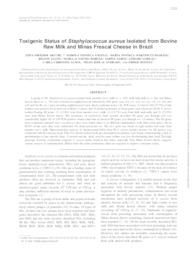Toxigenic status of Staphylococcus aureus isolated from bovine raw milk and minas frescal cheese in Brazil.
Toxigenic status of Staphylococcus aureus isolated from bovine raw milk and minas frescal cheese in Brazil.
Author(s): ARCURI, E. F.; ÂNGELO, F. F.; TALON, R.; BORGES, M. de F.; LEROY, S.; LOISEAU, G.; LANGE, C. C.; ANDRADE, N. J. de; MONTET, D.
Summary: A group of 291 Staphylococcus aureus isolates from mastitic cow's milk (n = 125), bulk tank milk (n = 96), and Minas frescal cheese (n = 70) were screened for staphylococcal enterotoxin (SE) genes (sea, seb, sec, sed, see, seg, seh, sei, selj, and sell) and for the tst-1 gene encoding staphylococcal toxic shock syndrome toxin 1 by PCR assay. A total of 109 (37.5%) of the isolates were positive for at least one of these 11 genes, and 23 distinct genotypes of toxin genes were observed. Of the S. aureus isolates bearing SE genes, 17 (13.6%) were from mastitic cow's milk, 41 (41.7%) were from bulk tank milk, and 51 (72.9%) were from Minas frescal cheese. The occurrence of exclusively more recently described SE genes (seg through sell) was considerably higher (87 of 109 PCR-positive strains) than that of classical SE genes (sea through see, 15 strains). The SE genes most commonly detected were seg and sei; they were found alone or in different combinations with other toxin genes, but in 60.8% of the cases they were codetected. No strain possessed see. The tst-1 gene was found in eight isolates but none from mastitic cow's milk. Macrorestriction analysis of chromosomal DNA from 89 S. aureus isolates positive for SE gene(s) was conducted with the enzyme SmaI. Fifty-five distinct pulsed-field gel electrophoresis patterns were found, demonstrating a lack of predominance of any specific clone. A second enzyme, ApaI, used for some isolates was less discriminating than SmaI. The high genotype diversity of potential toxigenic S. aureus strains found in this study, especially from Minas frescal cheese, suggests various sources of contamination. Efforts from the entire production chain are required to improve consumer safety.
Publication year: 2010
Types of publication: Journal article
Unit: Embrapa Dairy Cattle
Keywords: Minas frescal cheese, Staphylococcus Aureus
Observation
Some of Embrapa's publications are published as ePub files. To read them, use or download one of the following free software options to your computer or mobile device. Android: Google Play Books; IOS: iBooks; Windows and Linux: Calibre.
Access other publications
Access the Agricultural Research Database (BDPA) to consult Embrapa's full library collection and records.
Visit Embrapa Bookstore to purchase books and other publications sold by Embrapa.

